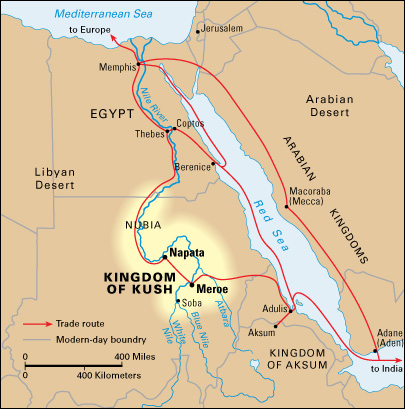Kush, also known as Meroe, was a kingdom along the Nile River in what is now northern Sudan. This region of Africa was called Nubia . Kush developed after 1000 B.C., at the end of a period of Egyptian control in Nubia. Between 750 and 660 B.C., the rulers of Kush conquered Egypt from their center at Napata. They became an Egyptian dynasty (family of rulers) known as Dynasty XXV. Kush eventually surrendered control of Egypt because of struggles with Assyrian invaders and Egyptian forces opposed to Kushite rule. However, Kush continued to prosper as an independent state south of Egypt. It was centered at Napata until about 250 B.C., and at Meroe until A.D. 350.

Culturally, Kush was a mixture of local Nubian and Egyptian practices. The Kushites built pyramids centuries after the Egyptian pyramids were constructed. Kushite pyramids were smaller than those in Egypt and were also shaped differently. Most Kushites spoke their own language, which was different from Egyptian. They also developed their own alphabet based on Egyptian writing and symbols. Kushites worshiped Nubian gods as well as ones borrowed from the Egyptians. Today, many of Kush’s pyramids and temples, as well as the ruins of settlements, still stand.

Kush’s wealth came from local natural resources and from trade. The region had iron, copper, and gold mines, and items made from these metals were exported. Kush also gathered such goods as ivory, ebony, and animal skins from other African states for trade to Egypt and other parts of the ancient world. In return, Kushites received glassware, fine metalwork, jewelry, and other manufactured goods.
